The AMD Radeon R9 290X Review
by Ryan Smith on October 24, 2013 12:01 AM EST- Posted in
- GPUs
- AMD
- Radeon
- Hawaii
- Radeon 200
Bioshock Infinite
Bioshock Infinite is Irrational Games’ latest entry in the Bioshock franchise. Though it’s based on Unreal Engine 3 – making it our obligatory UE3 game – Irrational had added a number of effects that make the game rather GPU-intensive on its highest settings. As an added bonus it includes a built-in benchmark composed of several scenes, a rarity for UE3 engine games, so we can easily get a good representation of what Bioshock’s performance is like.
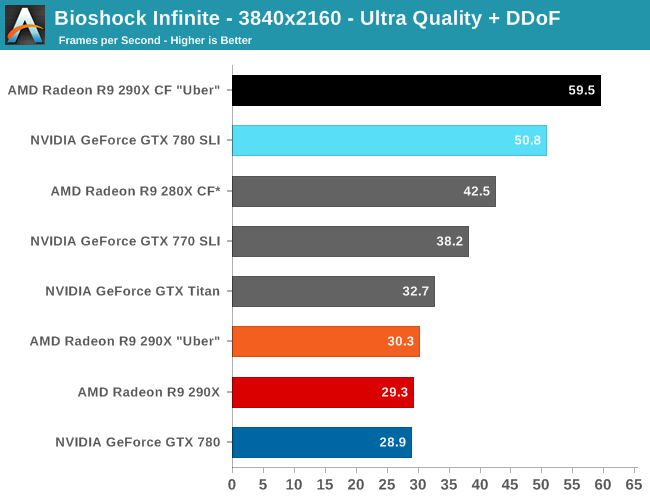

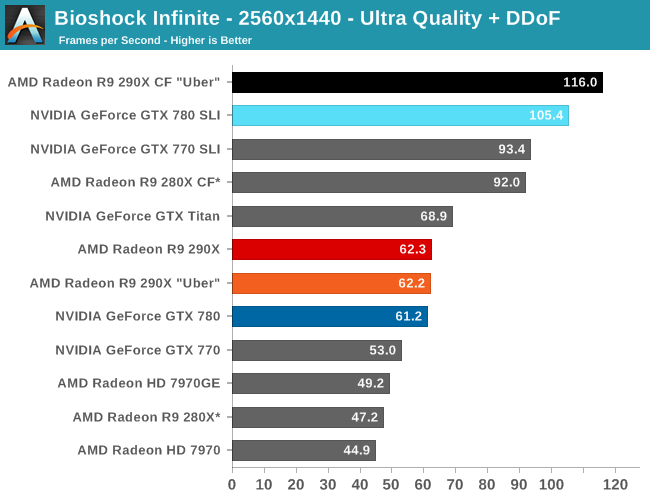
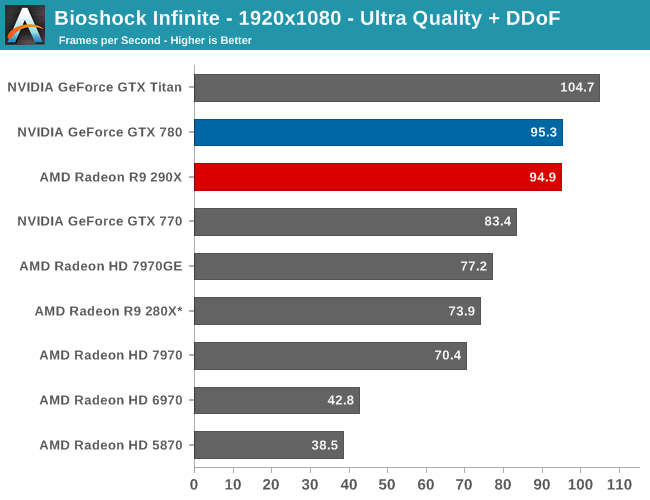
The first of the games AMD allowed us to publish results for, Bioshock is actually a straight up brawl between the 290X and the GTX 780 at 2560. The 290X’s performance advantage here is just 2%, much smaller than the earlier leads it enjoyed and essentially leaving the two cards tied, which also makes this one of the few games that 290X can’t match GTX Titan. At 2560 everything 290X/GTX 780 class or better can beat 60fps despite the heavy computational load of the depth of field effect, so for AMD 290X is the first single-GPU card from them that can pull this off.
Meanwhile at 4K things end up being rather split depending on the resolution we’re looking at. At Ultra quality the 290X and GTX 780 are again tied, but neither is above 30fps. Drop down to Medium quality however and we get framerates above 60fps again, while at the same time the 290X finally pulls away from the GTX 780, beating it by 14% and even edging out GTX Titan. Like so many games we’re looking at today the loss in quality cannot justify the higher resolution, in our opinion, but it presents another scenario where 290X demonstrates superior 4K performance.
For no-compromises 4K gaming we once again turn our gaze towards the 290X CF and GTX 780 SLI, which has AMD doing very well for themselves. While AMD and NVIDIA are nearly tied at the single GPU level – keep in mind we’re in uber mode for CF, so the uber 290X has a slight performance edge in single GPU mode – with multiple GPUs in play AMD sees better scaling from AFR and consequently better overall performance. At 95% the 290X achieves a nearly perfect scaling factor here, while the GTX 780 SLI achieves only 65%. Curiously this is better for AMD and worse for NVIDIA than the scaling factors we see at 2560, which are 86% and 72% respectively.
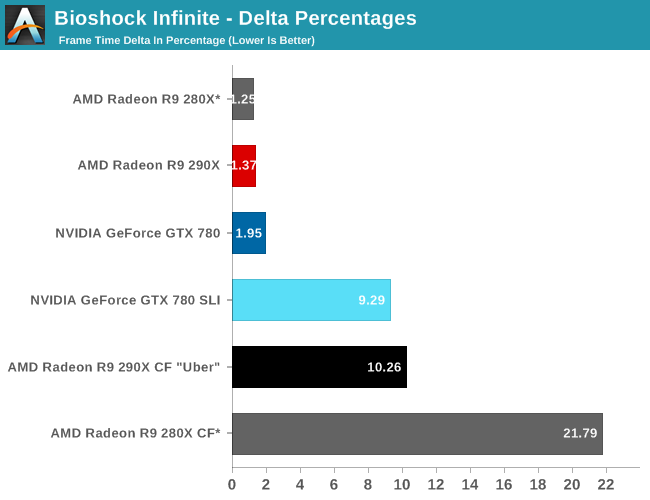

Moving on to our FCAT measurements, it’s interesting to see just how greatly improved the frame pacing is for the 290X versus the 280X, even with the frame pacing fixes in for the 280X. Whereas the 280X has deltas in excess of 21%, the 290X brings those deltas down to 10%, better than halving the variance in this game. Consequently the frame time consistency we’re seeing goes from being acceptable but measurably worse than NVIDIA’s consistency to essentially equal. In fact 10% is outright stunning for a multi-GPU setup, as we rarely achieve frame rates this consistent on those setups.
Finally for 4K gaming our variance increases a bit, but not immensely so. Despite the heavier rendering workload and greater demands on moving these large frames around, the delta percentages keep to 13%.


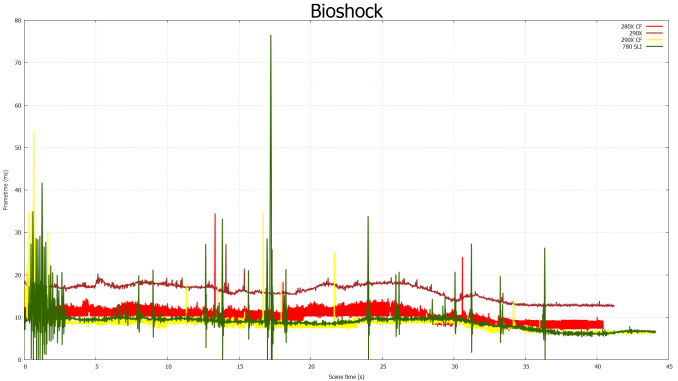









396 Comments
View All Comments
TheJian - Friday, October 25, 2013 - link
It's comic these people forget it's a $2500 card when supported as a pro card (tesla - with all the driver support). You are practically stealing it for $1000 already. It's not meant for GAMERS only. It's really meant for people who GAME that also like to make MONEY from their gpu with REAL apps...That concept always seems lost on the AMD lover (and even some NV people who apparently just don't understand the product or pricing on it).Sandcat - Thursday, October 24, 2013 - link
AMD plant.looncraz - Thursday, October 24, 2013 - link
Anything like an nVidia shroom?Homeles - Thursday, October 24, 2013 - link
I'd love to trip on some of those.jasonelmore - Thursday, October 24, 2013 - link
i'm reading the review and tbo the 290x peformance is around 5% lower than the GTX 780. Now if you go "uber mode" yes it does beat the 780 in several benchmarks, and does not in some, but ubermode is nothing more than a 15% overclock.. Stock for Stock 780 still is winning.jordanclock - Thursday, October 24, 2013 - link
Uber mode IS stock. Just like CPUs will boost up speed bins when they have the thermal headroom, so will the 290X. Excluding Uber mode is just trying to avoid the fact that the 290X tops the 780 in the highest of settings and sounds disengenuous.looncraz - Thursday, October 24, 2013 - link
As jordanclock stated uber mode is just a simple thermal mode setting.Just imagine what will happen with a better cooler and the card can run at full-tilt non-stop... With its clock often reduced by 10-15%, we could very well see some jumps where it currently doesn't beat everything outright - and crossfire configurations should greatly benefit. The power draw is unfortunate, but the reality is that few will really worry about it beyond their power supply limits...
If you leave the 290x in quiet mode and install better cooling, you will have the same performance as in uber mode (actually, probably better considering some are reporting bugs in the uber mode profile). Add to that the standard 5% or so gained in a few months of driver revisions, and the 780TI will need to be 5-10% faster than Titan to match the 290x in its non-reference clothing.
Steelytuba - Thursday, October 24, 2013 - link
Are you reading the same review I just read? The 780 is only slightly faster in a small number of the 1080p benchmarks against the 290x running quiet mode. If you run any resolution higher than 1080p (which is really the only reason you would need a card in this category) and even if you do run 1080p the 290x is the better performer for $100 less.Rontalk - Thursday, October 24, 2013 - link
Freqen Nvidia, give me back my $1000 !!!rituraj - Thursday, October 24, 2013 - link
Burn their office and then sue them